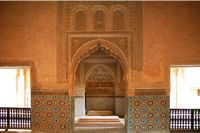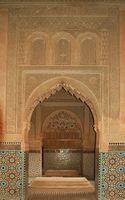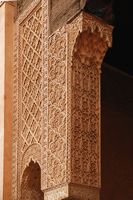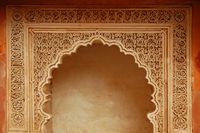 | The district of the Medina |  |
| |
|  General information General information | _small.png) The medina of Marrakech constitutes the nerve center and the historical heart of the town of Marrakech. Extending on a total surface from 600 hectares, it one of the vastest medinae of Morocco and are populated of North Africa. The medina of Marrakech constitutes the nerve center and the historical heart of the town of Marrakech. Extending on a total surface from 600 hectares, it one of the vastest medinae of Morocco and are populated of North Africa.The refinement and the urban specificity of the medina rise directly from the total virginity of the ground on which it was set up at the 11th century. Articulated around a military camping, Qsar El Hajar, and by a market, it was increased by a kasbah at the 12th century in order to protect it from the repeated attacks of the Berber tribes of the plain of Haouz, thus contributing to sit Almoravide hegemony durably. |
|
| | | Koutoubia mosque | | The Koutoubia mosque (in Arabic: الكتبية) is a religious building built at the 12th century and representative of the art of Almohades. The Koutoubia mosque, or mosque of the booksellers, was begun under the Berber dynasty from Almoravides in 1120, but was deeply altered starting from 1162 pennies the emir Almohade Abu Yusuf Yaqub Al-Mansur, and became one of the buildings most characteristic of this style. Its name comes owing to the fact that it was located in the souk of the merchants of manuscripts. The mosque of the booksellers is organized on a plan in T. This tradition exists since the construction of the mosque of Kairouan to the ix E century, and is also found in Spain. It acts by way of a hypostyle Arab plan, i.e. comprising a large court surrounded by a gantry and a room of prayer to columns. The naves are perpendicular to the wall of qibla, that of the center being broader; and the span which skirts the wall qibli is also magnified, which forms one T, from where the name. The mihrab is treated like a very major niche, and the minaret, high of 69 m, is of square section, according to the tradition of the Moslem occident. The Almohade dynasty, which adhered to the rite malikite, sponsored a rather austere architecture, reflecting a certain asceticism. The Koutoubia mosque does not make exception: its sobriety is noticed by its examination. The arcs employed can be exceeded or multifoil, but remain naked. The minaret later (completion in 1196), and is decorated more: one notices in particular an important work of interlaced arcs (sebka). It is surmounted by three gilded copper balls which would symbolize the terrestrial world, the celestial world and the spiritual world. It was useful, inter alia, of model for Giralda of Seville. The decoration external of the minaret is different on the four faces: painting on coating with ornaments floral and epigraphic, network of interlacing in relief where paintings are intercalated, earthenware stringcourse with white net on turquoise bottom, sometimes intermingled blind arcades. It is built out of schistous sandstone originating in the careers of Guéliz. Admirably proportioned: 12.80 on side for 69 height with the skylight (77 m to the point of the arrow), with a wall external of 2.50 Mr. With the center of the tower, an external core shelters six superimposed rooms. Around this one, a soft inclined slope leads to the covered way. The platform is surrounded by a covered way protected by a balustrade notched from merlons. The skylight, high of 16 m, seems a second minaret posed on the first. It is surmounted by a metal stem at which four gilded balls of decreasing size are fixed, largest being 6 m in diameter. They are made plates of gilded copper rivetted between them. The mosque of the booksellers preserves splendid a minbar going back to 1137, made in Cordoue for another mosque. As most those of occident, it mobile (on wheels), is composed of various wood turpentines but ivory. The invoice of the decoration, extremely fine, in openworks, would have taken seven years. It presents in particular small arcs stuck the ones to the others which mark emmarchements, and a taste of polychromy is notable there. | _small.jpg) _small.jpg) _small.jpg) | _small.jpg) _small.jpg) _small.jpg) | | Mosque El Mouassine | | The mosque El Mouassine is a religious building built at the 12th century with Marrakech and representative of the art of Almohades. This monument belongs to the complex “Mouassine”, including a library, an hammam, a médersa, and a fountain. The Mouassine fountain is a public fountain built at the time saadienne under the order of the sultan Abdallah el-Ghalib between 1562 and 1563, who is tallest of all the fountains of Marrakech. Located immediately north of the room of ablutions of the mosque, it is of rectangular form and measurement 18.10 m of length and 4.70 m of width and gathers three large feeding troughs covered of vaults and opened on the street by three arcades. | | Mosque with Gold apples | | The mosque with Gold apples is a religious building of the 12th century built under the reign of the sultan Yacoub El Mansour, located close to an old door of Marrakech (Bab Agnaou). Known in the past under the name of “mosque of El Mansour”, it was rebuilt in 1569 following an explosion, and re-elected “mosque with gold apples” because, according to a legend, the balls of its lantern would have been carried out with the gold of the jewels of the wife of Yacoub El Mansour (which made build Koutoubia). Long, she 80 meters recognizes herself with her minaret decorated with interlacing in rhombuses of turquoise color, surmounted multicoloured tiles. She is composed of a room of prayer and eleven naves. | | Palace of Bahia | | To go to the Palace of Bahia. | | Palace el Badiâ | | To go to the Palace el Badiâ. | | Musée Dar If Saïd | | The Dar museum If Saïd located at Marrakech, is entirely dedicated to the Moroccan craft industry of wood. Formerly a large residence built at the end of the 19th century by If Saïd, brother of Ba Ahmed, top dog of Moulay Abdelaziz and chamberlain of the Sultan Moulay Hassan 1st to be used to him as residence. Dar If Saïd were arranged in museum in 1932 by the Administration of Beautiful arts. The main part of the collections of this regional museum comes from Marrakech and the south and particularly from Tensift, of Under, of the High Atlas, the Anti Atlas, the Outlaw, Tafilalet. It is about homogeneous units of woodworks, jewels of the south, pottery and ceramics, of weapons, costumes and a rich collection of carpet and weavings of the South, and some archaeological parts of which the marble tank of the beginning of the 11th century. | | Palace Me nebbi - Museum of Marrakech | | To go to the Museum of Marrakech. | | Tiskiwin museum | | The museum Bert Flint or sometimes known under the name of Tiskiwin museum is located at Marrakech close to the palace of Bahia. This museum is an old residence of Bert Flint, dating from the beginning of the 20th century, become a museum dedicated to the Moroccan craft industry since 1996. Bert Flint, was a Dutch professor of art history and a traveller fascinated by Morocco and his culture, and this, during more than 40 years. In addition to its collections, the architecture of this residence is of hispano-Moorish type. Impassioned Moroccan popular arts, Bert Flint joined together a collection including of the musical instruments, the costumes, the jewels, the pieces of furniture, the carpets, the old ustensils and Berber craft industry of art, coming mainly from the valley from Under and of the Saharan area. Another section of the museum Bert Flint is at Agadir. | | Place Jamaâ El Fna | | Jamaâ El Fna (in Arabic: جامعالفناء) is a place located beside the Koutoubia mosque. | _small.jpg) _small.jpg) _small.jpg) | _small.jpg) _small.jpg) _small.jpg) | | This tourist high-place attracts unceasingly more than one million visitors come to attend the spectacles animated by the snake charmers, the adjusters of monkeys, the storytellers, the musicians and other artists popular (plays, drawing with the henna, etc…) beginning of evening until the call of the prayer of the paddle. It is also characterized by speakers who tell stories or praise the magic merits of products. | _small.jpg) _small.jpg) _small.jpg) | | Souks | | The souks of Marrakech, particularly famous places in Morocco where they cross, extend and intermingle in the medina with Marrakech. The souks of Marrakech gather a corporation of more than 40,000 Moroccan craftsmen. Of these corporations which governed formerly the souks, there remain only the names, and some craftsmen and maâlems (main) which still officiates in the middle of multicoloured quantities of gravers, of disordered odds and ends, where merchants of any age challenge the passers by. Shop El Edrissi Souk Sebbaghine Bradiaa, n° 16 and 18 | _small.jpg) _small.jpg) _small.jpg) | _small.jpg) _small.jpg) _small.jpg) | _small.jpg) _small.jpg) _small.jpg) | _small.jpg) | | The médersa Ben Youssef | | To go to the médersa Ben Youssef. | | Qoubba Almoravide | | Qoubba Almoravide, founded in Marrakech in 1064, constitutes the last vestige of Almoravides. Qoubba (“Arabic cupola”) was the center of ablution for the believers going to the mosque. The complex in activity during several centuries, was moreover one of the first fountains of the town of Marrakech and thus ensured the water provision of the population and their animals. The three fountains and the center of ablution were fed by a system of underground galleries (“will khettaras” in Arabic) which finished in a cistern from where interior bronze pipings brought water to the basins. This monument is also characterized by its arches finely engraved and its ceiling, which refers of this site of the dynasty of the almoravides. | _small.jpg) | | The Saadiens tombs | | The Saadiens tombs date from the time of the large sultan Ahmed Al-Mansur Saadi (1578-1603). These tombs discovered only around 1917, then were not restored by the service of the Art schools. They do not cease, since, to impress the visitors by the beauty of their decoration. The mausoleum shelters the bodies of about sixty Saadiens, of which Al-Mansour, its successors and his family. The building is composed of three rooms. The most prestigious mausoleum is the room of the twelve columns. This room shelters fall it from the sultan son Ahmed El Mansour. Its cupola out of wooden of worked cedar, and the stuccos are finely worked, the burials are there out of Carrara marble of Italy. This mausoleum constitutes very an good example of decorative art hispano-Moorish. Outside, are the tombs of the soldiers and servants and a garden of the necropolis. | _small.jpg)   |   | | The fountain chrob or chouf | | The fountain chrob or chouf located close to the mosque Ben Youssef in the middle of the medina of Marrakech, was high under Ahmed el-Mansour (1578-1603), her crowning is carried out out of wood in the form of honeycomb, the covered whole of a roof pitched covered with green tiles. The inscription engraved on the lintel is a Andalusian penmanship very similar to that of the Mouassine fountain. One of the engraved inscriptions invites the passer by “to drink and look at” (in Arabic “echroub or chouf”). This fountain saadienne is classified since 1985 world cultural heritage by UNESCO. | | Ramparts | | The famous ramparts of the old city of Marrakech underwent important modifications with the liking of the dynasties. Thus, they with many recoveries were bored of new doors (Arabic Bab). Today, the height of the walls oscillate between 8 and 10 meters and they extend at a total distance exceeding the 19 kilometers. | | The mellah | | The mellah, in the south is medina, was and remains today still, to a lesser extent, the Jewish district of Marrakech. Far from being a ghetto, the mellah gathered certain corporations which, as the history of Marrakech, became specialities of this community (the trade of Tisserand was an example of this phenomenon). It was founded in 1558 pennies the reign of Moulay Abdellah near the palace, which allowed, as it was the case with Fès for example, with the Sultan to better protect them. The synagog Salat Al Azama (in Hebrew: ביתהכנסתצלאתאלעזמה). |
|
| | |
|
 Other topics
Other topics